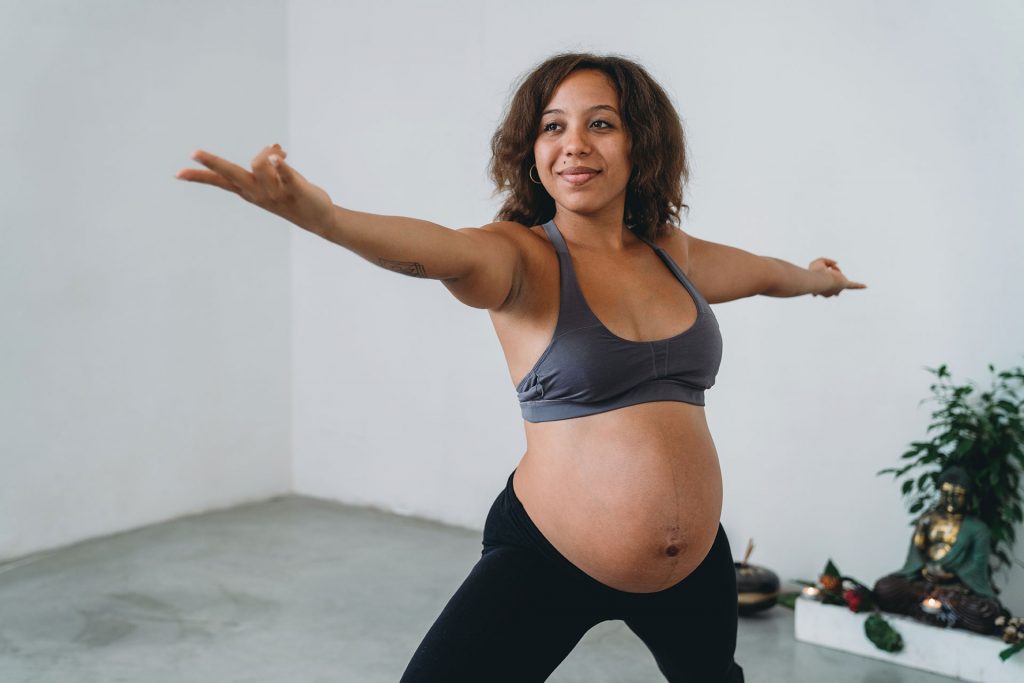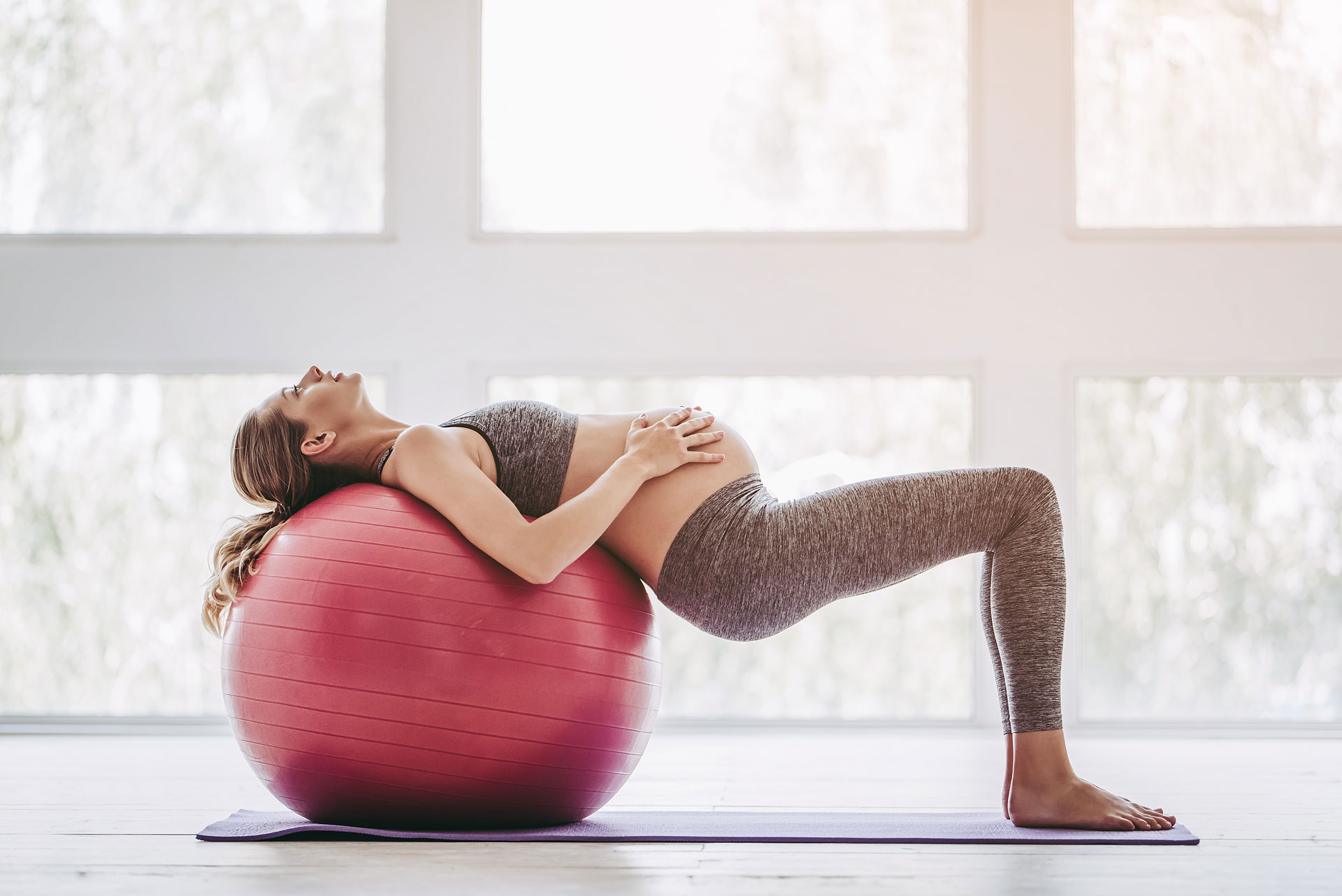Access and use of this article is subject to your acceptance of the Natalis Terms of Use.
Exercising when you’re pregnant can benefit you and your baby in a lot of ways. Not only will a little light physical activity boost your mood and improve your stamina, but it can also protect your body from common pregnancy complications such as pre-eclampsiai and gestational diabetesii.
Plus, pregnant women who regularly work out tend to have better luck managing discomforts like aches, pains and constipation. The key, according to doctors and fitness instructors alike, is to develop a safe routine that targets your problem areas while also accommodating your changing body. Here are a few exercise moves that do just that.
1. To reduce heartburn: try warrior pose
The Australian Government Department of Healthiii estimates that up to 80% of women experience heartburn during pregnancy. Instructors at the Prenatal Yoga Center in New Yorkiv suggest that a chest-opening yoga pose can provide welcome relief from this discomfort because the movement takes pressure off your oesophagus. One of the poses they recommend is the warrior pose, which you can comfortably try throughout your pregnancy.
To do the warrior pose:
- Place your feet a comfortable stride apart. Turn your body to the right, leaving your left foot at a 90-degree angle behind you.
- Slowly bend your right leg so you’re in a lunge position (if you find balancing difficult, you can do this exercise against a wall for support).
- Lift both arms above your head while keeping your left leg straight. Hold this position for a breath or two.
- Lower your hands to your left thigh and bend until you’re resting on your left knee. Hold this position for twenty seconds.
- Gently push yourself back up into a standing position. Then rotate your body and repeat the exercise on your other side.
Watch this Baby Center Australia demonstrationv to see the warrior pose in action.

2. To prevent diastasis recti: try the mermaid stretch
You’ve probably heard of “mummy tummy”, or diastasis recti, a very common condition that makes some women appear pregnant even after they’ve given birth. It happens because the muscles in your abdomen stretch to accommodate your growing uterus during pregnancy. While these muscles are supposed to bounce back in the weeks following labour, they sometimes lose their elasticity, causing a small pooch to linger below the belly button. According to the Australian Government website Pregnancy, Birth and Babyvi, strengthening your abdominal muscles in the early stages of your pregnancy can help prevent diastasis recti. Prenatal exercise specialist Erica Zier recommends the mermaid stretchvii as one easy option.
To do a mermaid stretch:
- Sit with your feet bent and swept to the side as if you are a mermaid (start with your right leg in front with your left leg tucked behind).
- Place your right hand on the floor beside you.
- Inhale as you reach up with your left arm.
- Using your right elbow for balance, lift your hips. Then exhale as you slowly lower your hips down again and move back into a sitting position.
- Do three of these on each side.
Watch this video with corrective exercise therapist Cait Morthviii to see a mermaid stretch in action.
3. To improve your balance: try plié squats
As your belly grows, your body’s centre of gravity will shift, which is why it’s important to find an exercise that targets your balance and coordination. The medical team at Healthlineix suggest doing plié squats (also known as sumo squats) because they strengthen your hips and legs.
To do a plié squat:
- Stand with your feet hip-width apart, turning your toes and knees out at a 45-degree angle (you can rest your hand against the wall or the back of a chair if you need to).
- Bend your knees and squat as low as you can manage, making sure your knees are not extending out past your feet and that your belly button is tucked in.
- Rise again, then repeat. If you feel like you can keep your balance, let go of your support and sweep your arms in a hugging motion with every squat.
- Aim for 15 plié squats three times a week.
Watch this Mother and Baby demonstrationx to see a pliésquat in action.
4. To strengthen your arms: try a curl and press
This dumbbell exercise is great for strengthening your biceps, which will prepare you for lifting and carrying your baby. According to Baby Center Australiaxi, it’s safe to use light weights in your first and second trimester as long as they aren’t heavier than 2.5kg but chat to your doctor if you have any concerns.
To do a curl and press:
- Stand with your feet hip-width apart and hold a light dumbbell in each hand.
- Slowly curl the weights up to your shoulder and hold.
- Then press your arms above your head and hold.
- Repeat this 15 times, resting when you need to.
5. To protect your posture: try a lateral raise
Naturally, your posture is going to change during pregnancy as you readjust how you stand, walk, sit and lie to reduce strain on your back. A seated dumbbell exercise like a lateral raise (similar to a curl and press) will encourage you to fix your posture and fight the urge to slouch.
To do a lateral raise:
- Sit in a chair and hold a dumbbell in each hand, with your palms facing your body.
- Pull in your navel and squeeze your shoulder blades back.
- Slowly lift the weights to shoulder height and down again.
- Repeat this ten times, resting when you need to.
6. To reduce back pain: try a pelvic tilt
Even with a posture-training exercise, the extra weight you’re carrying around will cause you to curve your lower back more, which can lead to persistent aches and pains. This is why pelvic tilt exercises are another must during pregnancy. While traditional pelvic tilts are done on the floor, What to Expectxii recommends performing this exercise in a standing position after your fourth month of pregnancy. Exercising on your back is dangerous after your first trimesterxiii because you can cut off your circulation.
To do a pelvic tilt:
- Stand straight with your back against the wall.
- Breathe in deeply and flatten the small of your back against the wall.
- Exhale and relax. Then repeat.
- Continue this exercise for about five minutes. You can do this several times a day to help alleviate any soreness.
7. To relieve gas: try an open-seated twist
Let’s face it: pregnancy makes you gassy. At a certain point, your uterus starts putting pressure on your intestines and slowing down your digestion, causing constipation and, well, flatulence. According to Medical News Nowxiv, a yoga movement like the open-seated twist, which puts pressure on your core while safely leaving room for your belly, can effectively release trapped gas.
To do an open-seated twist:
- Sit with your legs crossed and your back straight. Place your right hand on the floor behind you.
- Rest your left hand on your right knee and gently twist your torso. Hold for ten seconds.
- Exhale as you return to a front-facing position.
- Repeat the twist on your other side.
Watch this Yoga With Adriene demonstrationxv to see an open-seated twist in action.
8. To strengthen your pelvic floor: try Kegels
Kegel exercises help strengthen the muscles that support your bladder, uterus, and bowels, all of which are essential during labour. Training your pelvic floor regularly throughout your pregnancy will help you to relax and control these muscles when you need to. The best part is that you can do them anywhere, including during a Netflix binge on the couch or when you’re answering emails at work, and no one will even know.
To do a Kegel exercise:
- Imagine you have to urinate and then pretend to hold it.
- Tighten these muscles for three seconds without moving your legs, hips or abdominal muscles, and then relax for three seconds.
- Pregnancy, Birth and Babyxvi recommends doing this about 12 times in a single sitting, at least three times a day, from your first trimester onwards.
Of course, a smart exercise routine is only half the battle – you also need to follow a smart diet to see real results. Make sure you’re cutting out those pesky sugary treats, eating high protein snacks throughout the day, staying hydrated and supplementing your meals with a multivitamin like Natalis to get your all-important pregnancy nutrients. You’ll know everything was worth it when you come face to face with your healthy new bundle of energy.
Please always seek professional advice before exercising if you have any concerns.
References
i https://www.betterhealth.vic.gov.au/health/healthyliving/pregnancy-and-exercise
ii https://www.diabetesaustralia.com.au/news/incorporating-exercise-into-your-pregnancy/
iii https://www.health.gov.au/resources/pregnancy-care-guidelines/part-i-common-conditions-during-pregnancy/reflux-heartburn
iv https://prenatalyogacenter.com/blog/pregnancy-and-heartburn/
v https://www.babycenter.com.au/v1036704/modified-warrior-pose-pregnancy-yoga-video
vi https://www.pregnancybirthbaby.org.au/abdominal-separation
vii https://knocked-upfitness.com/pregnancy-exercise-mermaid-stretch/
viii https://www.youtube.com/watch?v=sZVhfTjIOlg
ix https://www.healthline.com/health/pregnancy/squats
x https://www.youtube.com/watch?v=_pkqCoiHRrY
xi https://www.babycenter.com.au/a7878/weight-training
xii https://www.whattoexpect.com/pregnancy/keeping-fit/week-33/tilt-it.aspx
xiii https://www.betterhealth.vic.gov.au/health/healthyliving/pregnancy-and-exercise
xiv https://www.medicalnewstoday.com/articles/positions-to-relieve-gas-while-pregnant#twists
xv https://youtu.be/0cKnStmV1dI?t=487
xvi https://www.pregnancybirthbaby.org.au/pelvic-floor-exercises
